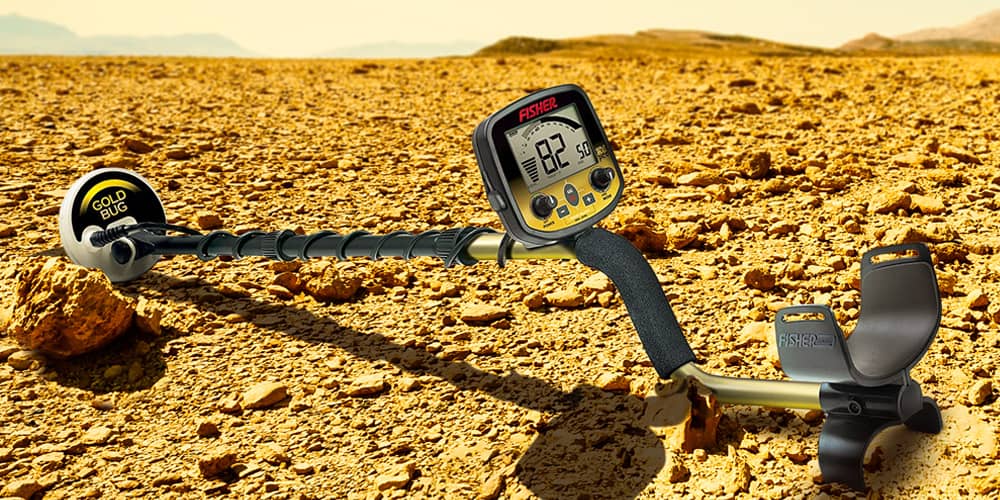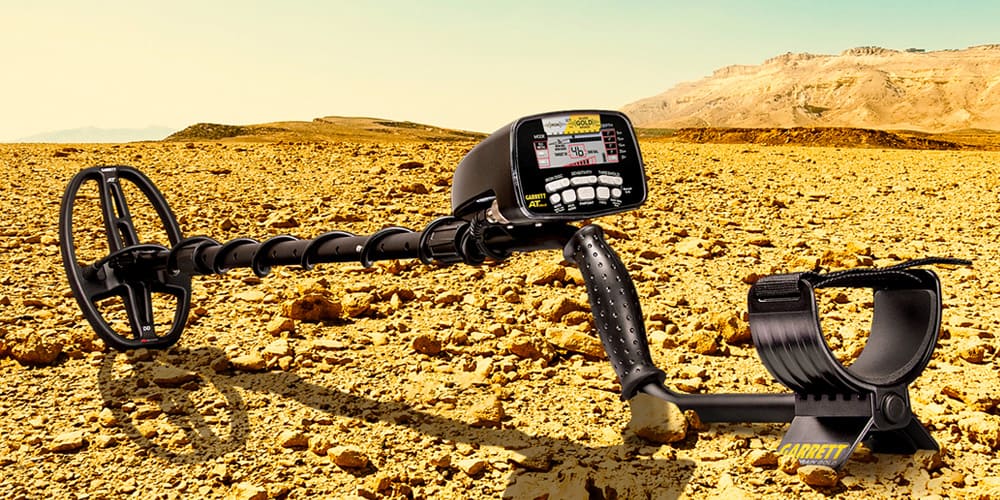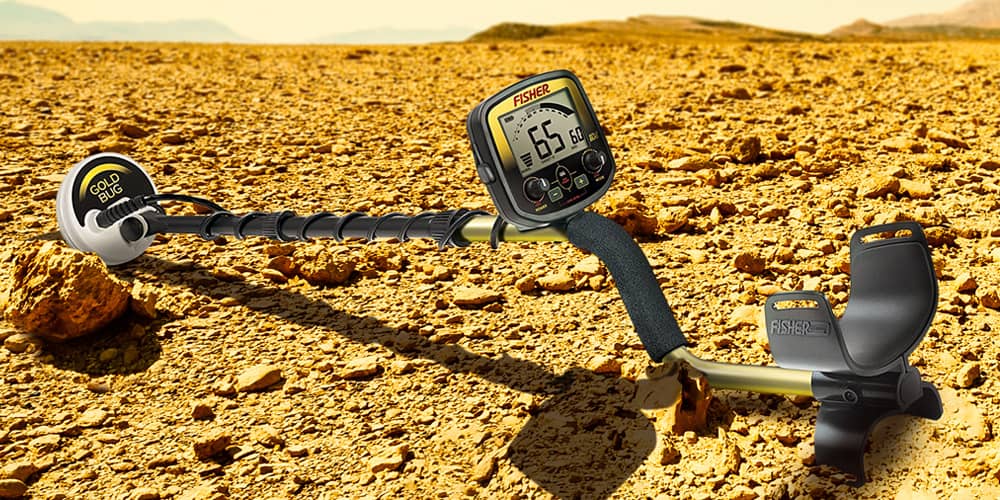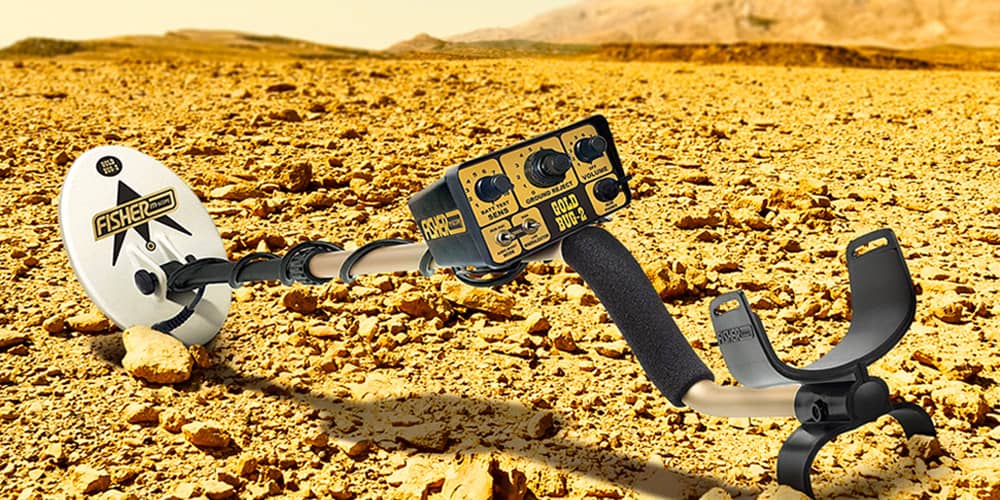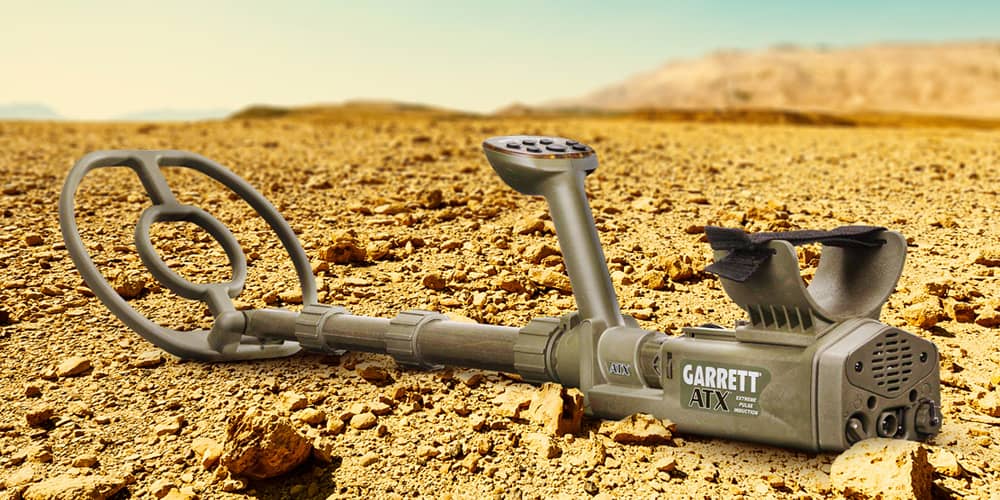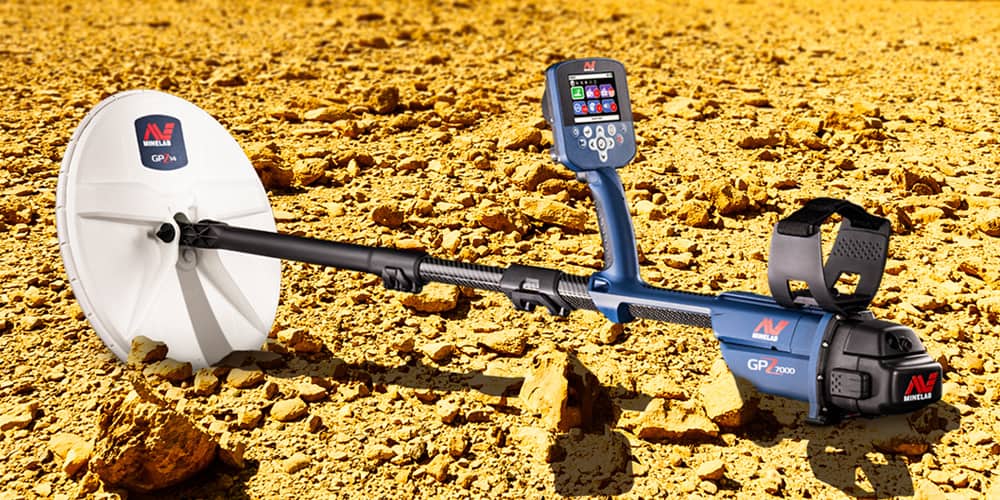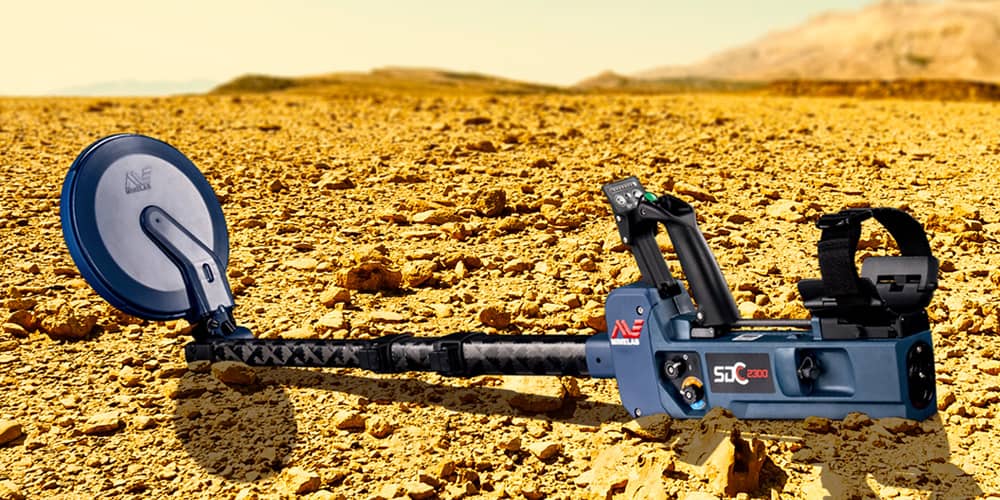Are you looking for the best metal detector for gold and are flabbergasted by all the choices – and the crazy price tags? This article will help make your decision a no-brainer.
Our top pick for all-around prospecting is the Fisher Gold Bug Pro; a powerful gold detector that’s perfect for beginners and those on a budget.
We recognize that not everyone has the same intended use, skill level, or budget. That’s why we give you several recommendations in this guide. So, what are the best metal detectors for gold?
Best Entry-Level Gold Detectors
- Fisher Gold Bug Pro: Best in it’s class
- Garrett AT Gold: Waterproof. Easy to use. Also used for coins/relics
- Fisher Gold Bug: Also recommend entry-level
Best Intermediate Gold Detectors
- Fisher Gold Bug 2: Most sensitive to small nuggets in neutral ground
- Garrett ATX: Submersible to 10′, a PI gold detector also great for saltwater and relic hunting
- Minelab Gold Monster: Best option in it’s class for automatic sensitivity and ground tracking
Best Expert-Level Gold Detectors
- Minelab GPZ 7000: Best of the best
- Minelab GPX 6000: Also recommended for serious gold prospectors. Most coils and accessories.
- Minelab SDC 2300: Easiest expert-level detector to use for less serious gold prospectors
* The GPZ 7000 uses Zero Voltage Transmission (ZVT) which effectively gives you two machines in one – a deep PI machine, and a high-frequency VLF machine.
Top Picks Reviewed
There are many different types of detectors on the market today, but not all are worth your time or money. We’ve reviewed some of the best metal detectors for gold to make your search easier! Read on to see which one is right for you.
Fisher Gold Bug Pro
The Fisher Gold Bug Pro is the easiest way to find tiny gold nuggets. A great value for beginners.
The Fisher Gold Bug Pro’s advanced features and controls make it an excellent choice for both beginners and experienced treasure hunters alike. It differs from the regular Gold Bug in that it’s more sensitive to small nuggets, has both manual and automatic ground grab, and has a voltage-controlled oscillator (VCO) audio response in both all-metal and discrimination modes.
If you’re a gold prospector, then you know that there are many different metal detectors to choose from. But if you want one detector that can handle all of your treasure hunting needs, the Fisher Gold Bug Pro could be the right choice for you.
The Gold Bug Pro’s design makes this possible with its separate control over signal gain and threshold, as well as its sophisticated ground balancing system. It also includes a unique discrimination control system that allows users to effectively eliminate unwanted targets such as iron or foil without sacrificing sensitivity to small nuggets of gold. All these features combined make the Gold Bug Pro an ideal choice whether searching for gold in streams or backyards, relic hunting on old battlefields, or even just doing some casual beachcombing!
Garrett AT Gold
The Garrett AT Gold is an all-terrain gold detector that’s rugged, easy-to-use, and lightweight. Can also be used for other types of detecting like coins, jewelry and relic hunting.
The Garrett AT Gold makes gold prospecting easy for beginners and experts alike. Its lightweight design means you’ll have less fatigue while looking for gold, and its waterproof body allows you to hunt in freshwater lakes and streams. Almost all detectors have a waterproof search coil, but few are fully waterproof. It was designed from the ground up specifically for beginners in mind. It includes all of the features that experienced hunters have come to expect from Garrett metal detectors, plus some additional bells and whistles that make it easier than ever before for newcomers to learn how to hunt for gold!
The AT Gold is an excellent mid-priced metal detector that includes all the features you need for successful gold prospecting, like manual and automatic ground balance modes, plus an exclusive Ground Balance Window™ feature that optimizes its performance in the highly mineralized ground where most of the gold is found. It’s also waterproof up to 10 feet so you can hunt in lakes and streams without worrying about damaging your machine.
Fisher Gold Bug
The Fisher Gold Bug is a high-quality gold prospecting detector for beginners that won’t break the bank.
The Fisher Gold Bug metal detector takes the frustration out of gold prospecting by making it super easy to find small nuggets, while still being great at finding relics and other treasures. It’s an affordable way to get into the hobby without breaking your budget—or your heart if you don’t strike it rich right away.
The Gold Bug has all of the features you need in a prospecting detector without any of the extra bells and whistles that make up most top-of-the-line models. With its simple controls, digital display, easy operation, and reliable performance, this is one smart machine for serious treasure hunters looking to take their game up a notch—whether they’re beginners or experienced pros!
Fisher Gold Bug 2
The Fisher Gold Bug 2 is most sensitive gold prospecting detector for small nuggets in neutral ground.
The GoldBug 2 is a high-frequency detector designed for finding small gold nuggets.
Most people who are serious about metal detecting focus on the larger gold nuggets that can be found with lower frequencies, however, there is a large market of hobbyists and first-timers who want to find smaller pieces of gold. These people may not have the experience or patience for lower frequencies which require more time and effort to master. Higher frequencies make it easier to detect smaller targets but they also make it harder because you will pick up interference from ground minerals as well as hot rocks. This means you need both an experienced user and someone willing to put in the work learning how to use this device properly.
Fisher has developed a solution specifically targeted at these two groups by developing a high-frequency detector that provides better performance than other devices on small targets while still providing enough sensitivity so that inexperienced users won’t get overwhelmed by false signals from hot rocks and ground minerals like iron content and salt.
This detector has a steeper learning curve than any of the other Gold Bug models. And unlike other Gold Bugs, it should not be used for other types of detecting like coins, jewelry, or relics.
Garrett ATX
The Garrett ATX is the best all-terrain, submersible, pulse induction metal detector for gold prospecting.
The ATX is a highly advanced pulse induction detector that was designed with one goal: to overcome challenging environments like extremely mineralized soils or saltwater conditions. It’s perfect for both gold prospecting and relic hunting, highly sensitive on tiny gold nuggets, fully waterproof up to 10 feet, and has a wide range of ground balance without switching modes.
Garrett has been making metal detectors for over 50 years and they’re one of the most trusted brands in the industry. No matter where you’re searching for treasure, this pulse induction detector will help you succeed and make finding gold easy and fun!
Minelab Gold Monster 1000
The Minelab Gold Monster is the best option in its class for automatic sensitivity and automatic ground tracking
The Gold Monster is a mid-frequency (45 kHz) fully automatic metal detector designed to make finding gold as easy as possible. It’s perfect for those who want to go out and have fun, not spend all day with their head buried in an instruction manual trying to figure out how their machine works. With one push of a button, you’ll be detecting like a pro.
This machine can also handle a wide range of nugget sizes without introducing excess noise and false signals into the ground. It also has basic controls with an easy-to-use interface so anyone can use it right away. You’ll also love its improved ferrous/nonferrous discrimination as well as its ability to cope with conductive soils. It’s exclusive “Gold Chance Indicator” feature makes finding gold easier than ever before!
Minelab GPZ 7000
Best of the best (and most expensive). Up to 40% deeper than GPX 6000.
The GPZ 7000 is the most advanced and most expensive gold detector on the market. It can go deeper than any other detector—up to 40% deeper than any other metal detector on the market today.
Minelab has been in the business of making high-end detectors for over 35 years and they have made some incredible technological advancements with this new model. It’s so advanced that it’s going to change the way we think about hunting for gold forever.
The GPZ 7000 is an amazing piece of technology that combines advanced design with extreme power for maximum performance. By using this state-of-the-art metal detector, you’ll be able to find more gold than ever before. And because it’s so easy to use, anyone can start finding treasure immediately—assuming you can afford it!
Minelab GPX 6000
Highly recommended for serious gold prospectors. Most coils and accessories.

Minelab’s GPX 6000 metal detector is built by the world leader in gold detection technology and has all of the features you need to make your search for gold easier than ever before. This detector was designed specifically for serious prospectors who want to find real gold nuggets fast—the type of nugget you can retire on!
This advanced metal detector has built-in GeoSense-PI technology which automatically identifies ground conditions so you don’t have to worry about manually adjusting settings for depth and sensitivity when hunting in different environments like beaches, mountains or streams. With its Automatic Ground Balance feature, the GPX6000 will quickly adapt to changing soil conditions without any user input required!
Minelab SDC 2300
Easiest expert-level detector to use for less serious gold prospectors.
The Minelab SDC 2300 is a high-performance, mid-range, and versatile detector designed to find small gold nuggets and in all types of ground conditions—even underwater.
The SDC 2300 offers high performance at an affordable price with military-grade construction and MPF technology. It’s super compact, easy to use, and super sensitive so that even small nuggets can be detected in mineralized ground where other VLF and PI machines fail.
Buying Guide
Ever since James Marshall’s 1848 discovery of gold at Sutter’s Mill, gold prospecting in the United States has been the ultimate treasure hunt. Prospecting gold nuggets with a metal detector is a thrilling hobby that’s both fun and (financially) rewarding. But with so many machines on the market, how do you know which is the best metal detector for gold?
This go-to guide is packed with useful information that will help you make the right choice so you can start digging your very own gold. For other types of detectors, see our complete guide to the best metal detectors.
How to Choose
Before we get started, I want to make a public service announcement if I may. All metal detectors will find gold nuggets if they’re in the ground (and big enough) – not just gold detectors. A gold metal detector is simply a detector designed specifically to detect tiny targets in mineralized ground. That’s pretty much it. So what makes a good gold detector?
It may surprise you that it’s much easier than you think to choose the right detector. Some of the biggest factors include:
- Where (geographically) you’ll be doing most of your gold prospecting.
- The size of gold nuggets that have been found there in the past. If you don’t already know, I recommend joining a local prospecting club or talking to local claim owners.
- Ground conditions. Is it highly mineralized? Is there a lot of trash?
- Other uses. Do you want to use the same detector for coin, jewelry or relic hunting?
- Budget.
You’ll need to ask yourself these questions before you even consider which detector you’ll buy.
Spoiler alert: there is no universal ‘best metal detector for gold’. (Although the GPZ 7000 is close for those of you who can afford a detector that’s the same price as a car).
The question should be, what is the best gold detector for your answers to the above questions? Just because the Minelab GPX 5000 costs more than 6x the amount of the Fisher Gold Bug 2, doesn’t mean it’s better.
If I were hunting in low/moderate ground on top of bedrock in an area where the nuggets tend to be small, I would actually opt for the Gold Bug 2 over the GPX 5000. Am I crazy? No….not the last time I checked anyway…
Now let’s dive into the reasons why this is the case by deciphering the most important elements of any gold machine.
Detector Technology
The first thing you have to decide is which technology to use – VLF or PI.
VLF stands for Very Low Frequency and is the same technology used in detectors built for coins, jewelry, and relics. VLF detectors broadcast at frequencies measured in kilohertz ranging from 3 kHz to 70 kHz. Here are five reasons why you might choose a VLF over a PI
- You’re a beginner.
- You want to use the same detector for other detecting like coins, jewelry, relics. (Read more on the best metal detector for coins).
- You’re hunting for small to medium-sized nuggets at depths under 8” (most common).
- You’re hunting in areas with lots of trash and need to discriminate.
- You want to spend less than $2,000
PI stands for Pulse Induction and is used in specialty detectors designed for maximum depth in highly mineralized ground. PI detectors broadcast pulses and are measured by pulses per second. Here are five reasons to opt for a PI machine over a VLF:
- You’re an experienced gold hunter.
- You want a specialty machine built just for gold nugget hunting.
- You’re hunting for larger gold nuggets at greater depths AND aren’t so much interested in the smaller, shallower nuggets.
- You’re hunting in highly mineralized ground with low levels of trash.
- You have over $2,000 to spend.
Now that we’ve identified the two camps let’s talk about some technical differences.
Operating Frequency
We already discussed that VLF detectors are best when searching for nuggets that are small to average in size. The next thing to decide is the operating frequency of the VLF.
As mentioned above, VLF machines typically range from 3 kHz to 70 kHz with the most popular gold VLF machines in the 13-50 kHz range. That is a huge range. So which is better? Again we go back to nugget size.
Side note: This guide is not about where to find different-sized nuggets, but larger nuggets will most often be at the highest elevations of your site, while the smallest will be at the lowest elevation – usually in a stream bed. In the United States, larger nuggets are most often found in Alaska, medium in the Western States, and small in the Eastern States. The biggest and best nuggets in the world are typically found in Australia.
Now back to the techy stuff…
There is an inverse relationship between frequency and nugget size (as well as maximum detection depth). Both lower frequency VLF and PI detectors will find larger nuggets at greater depths – but will struggle to find smaller nuggets at shallow depths. Alternatively, higher frequency VLF machines are better at finding smaller nuggets at shallow depths – and struggle to get greater depths.
So which is better? Well, neither…It all depends on your particular area and what’s been found there before (and at what depths).
The same concept holds true for search coil size. Again there is an inverse relationship where larger coils get bigger targets at greater depths, and smaller coils get smaller targets at shallow depths. Smaller coils are also better for rocky areas where you need to maneuver around large rocks and get into tight spaces. They’re also preferred over large search coils in highly mineralized ground since they will ‘see’ less of the ground at any given time.
Let’s revisit my comparison at the beginning of this article between the GPX 5000 and Gold Bug 2 to help understand my reasoning. The Gold Bug 2 is a 71 kHz VLF machine with a small, 6.5” coil. The GPX 5000 is a PI machine with a large 11” coil. So if you’re hunting on bedrock in an area with small nuggets and ground that is not highly mineralized, the Gold Bug 2 is the clear choice. Using the GPX 5000 in this scenario might actually cause you to miss nuggets altogether! I don’t know about you, but I’d rather dig several small nuggets than no nuggets at all because my machine is only looking for large ones.
Mineralization
Another factor in determining what range of frequencies to look for when choosing a gold detector is the ground mineralization for where you’ll be hunting. After all, gold is most commonly found in areas of mineralization – at least to some degree.
Lower frequency VLF and PI machines will handle high mineralization much better than high-frequency VLF. If you’re in areas of extreme mineralization such as black sand in a stream bed, then a PI will likely be your only option as it will see through the ground and not false. So you probably don’t want to hunt with the Gold Bug 2 for example if you’re in areas of high mineralization if you want to avoid constant falsing.
Another feature to consider when dealing with mineralization is the ground balance. Almost every gold detector comes with automatic ground balance (or ground tracking) – but not all ALSO have manual ground balance. So I recommend you invest in a machine that has both forms of ground balancing.
Is your head spinning yet? It’s really not as complicated as I’m making it sound. In fact, it’s probably more complicated for me to explain all this in writing than it is to decide on a detector.
Discrimination
In addition to the varying degrees of ground mineralization, you also need to consider how much trash is in the ground. Now I use the term trash loosely here. When I say trash, I’m referring to anything that’s not gold.
VLF detectors have the advantage of electronic metal discrimination – meaning you can choose to ignore trash signals and only focus on good, gold signals. Alternatively, PI detectors either struggle with discrimination or have none at all.
So if you know you’ll be in areas with a high trash density, you might do well to opt for a VLF detector. Otherwise, you’ll spend your entire day digging trash.
Parting Words
That wasn’t so bad, was it? If you’re new to metal detecting and these concepts are not already familiar to you, I recommend reading this article a few times. Once you understand everything we’ve talked about in this article, your biggest question should be: “What if I want to find both small shallow, small nuggets, AND large, deep nuggets?”
Excellent question!
The reality is that unless you can anti-up for a Minelab GPZ 7000, you’re going to want two machines. My best advice is to get the Fisher Gold Bug 2 for your small, shallow gold, and whichever of the Minelab PI machines your budget allows for the deep, larger nuggets.
Accessories
Now that you have a better idea of which gold detector is best for you, here are a few accessories I highly recommend for all prospectors:
- Plastic scoop to wave dirt/rocks over coil during recovery.
- Pick to hammer through rocky ground
- Pinpointer or coil probe to quickly pinpoint those small nuggets
- Coil Cover to protect your coil from damage
- Vials to store your fine gold
- Shoulder or chest harness to take the weight of the detector off your arm
- Different coils to adapt to the location your hunting
- Headphones to hear those faint gold signals
- Strong Magnet to quickly pickup iron trash and ‘hot rocks’ before digging
FAQ
What is the difference between a regular metal detector and a gold detector?
Gold detectors and coin/relic detectors can be very different. Gold detectors work best in the all-metal mode, while coin detectors work best in the discriminate mode. Gold detector frequencies are made to detect highly conductive targets, while coin and relic detector frequencies are made for detecting more low to mid-ranged time-constant targets like silver. Gold machines also have to be able to handle ground mineralization since that is where gold is most often found.
What frequency is best for gold detecting?
The best frequency depends on where you’ll be hunting and what size nuggets you expect to find. Higher frequency detectors will be better for smaller nuggets whereas lower frequency will be best for larger nuggets. Something in the middle will be better for medium-sized nuggets. Gold detectors typically range from 3 kHz to 70 kHz with the most popular ones between 13-50kHz.
How deep can metal detectors detect gold?
A metal detector will find tiny gold only within 2 inches of the coil. If you are looking for bigger gold, it can be found more than 8 inches deep depending on the type of metal detector and how good you are at doing it.
How can you tell if gold is in the ground?
Search for information about the area you want to prospect. Don’t just search for places where gold was found. You should also look at the size of the gold that was found in these areas. Some places discovered only very little gold. Gold can sometimes be found with little overburden, which is dirt and rock on top of it, so that is another thing you should look at. Get topographical maps of the area and learn how to recognize gold mining landmarks on them so you know where to go looking for gold nuggets.
Where do you find gold with a metal detector?
The best places to detect will vary based on where you live in the world. We have an entire article on where to metal detect for gold.
How much is a metal detector that detects gold?
Metal detectors that detect gold can cost as little as $300 all the way up to $7.000+ depending on the features you’re looking for.
Is there a metal detector that only detects gold?
No. All metal detectors detect metal objects. Gold is metal so any detector will be able to detect gold. Because most gold you can find with a metal detector is so small and in highly mineralized ground, there are detectors designed for the job.
What is the best metal detector for gold in Australia?
Since Minelab is an Australian company, I would recommend any of their gold machines for detecting in Australia as they will be the most tuned for the conditions. Australia’s goldfields are heavily mineralized so you’ll want a detector that uses pulse induction technology. PI will be able to penetrate deeper into the ground, making it more efficient at finding gold nuggets over standard VLF machines.
Can a cheap metal detector find gold?
Yes, any metal detector is capable of finding a gold nugget. But it has to be big enough and close enough to the surface. These types of nuggets are extremely rare so the chances you’ll find gold with a cheap detector aren’t great.
Who makes the best gold metal detector?
Minelab makes the best metal detectors for gold. There are many top brands out there, but Minelab has the most advanced technology available on the market today.
Which Minelab detector is the best for gold?
The GPZ 7000 is the best, most expensive metal detector that Minelab makes. It can go much deeper than other metal detectors on the market—up to 40% deeper. This is an amazing piece of technology. It uses an advanced design with extreme power for maximum performance. The GPZ 7000 can find more gold than ever before.
Final Word
If you’ve reached this point in the article, congratulations! You now know everything there is to know about gold detectors. Here’s a quick recap:
- Fisher Gold Bug Pro: Best for beginners and our top pick for all-around prospecting.
- Minelab Gold Monster: Best intermediate gold detector for a wide range of nugget sizes.
- Minelab GPZ 7000: The most advanced gold detector on the market. You’ll think this thing is making gold on it’s own!
Now it’s time for you to go buy one and get started finding some treasure! I hope this article was helpful and puts you on the right path for choosing the best gold metal detector for your needs. Happy hunting!

